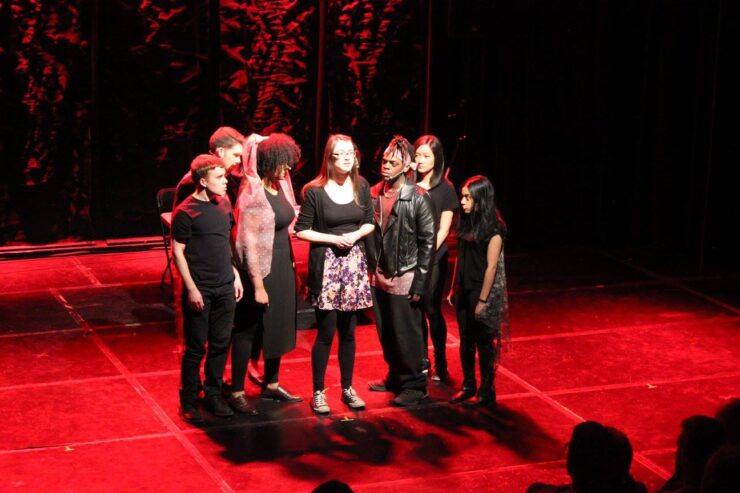Faculty forced to study new options to remain relevant, but no solution yet
The University of Ottawa’s Faculty of Arts has faced declining enrolment yet again last year, a trend that began over a decade ago. As the number of registered students continues to dwindle, the Faculty still has no clear solutions in sight.
“English enrolment has declined precipitously in the last five years. There’s been a steady decline over the last 10 years, I would say,” said Robert Stacey, professor of Canadian literature professor and director of undergraduate studies for the Department of English at the U of O. “There’s been a general trend in decline in humanities enrolment.”
Statistics from the U of O show a decline that may look subtle, but is still worrying. In 2007, the Faculty of Arts had 6,250 full-time and part-time undergraduate students. Enrolment for the Faculty of Arts peaked in 2010 at 6,637 students, something that Stacey attributes to the ‘double cohort’ when Grade 13 was phased out. Enrolment in the arts now sits at 4,699 students as of 2016, a drop of almost 1,000 students from 2014.
In contrast, the Faculty of Engineering has gone from 1,956 students in 2007 to 4,054 in 2016. Though the number of students are comparable, engineering has been rising up, while the arts are sliding down.
In fact, student numbers have increased in the Faculties of Science, Social Sciences, and the Telfer School of Management, though not to the same extent as engineering. In short, only the Faculty of Arts is losing students.
The hardest hit departments have been English—with numbers nearly halving over 10 years—philosophy, French, and history. Translation and communications are the only departments that have shown growth over the years.
Though reasons are many, vocational training—or the veneer of vocational training—may be to blame. Arts degrees are notoriously slandered as being next-to-useless, while it is hard to argue the same for the sciences or engineering.
“Whereas there would have been a time where more practical, professional degrees would have to explain themselves because they weren’t humanities education, they weren’t ‘Letters’ … the humanities now have to constantly justify themselves,” Stacey said. “There has been a sea change in general attitudes across the West … education has now come to be understood as preparation for a career, and English doesn’t necessarily do that or seem to do that in a direct way.”
It’s notable that only communications and translation have escaped the slow decline over the years. Translation offers the most vocational education in the faculty, specifically teaching students how to translate. It’s a valuable program in a bilingual country, with government jobs almost assured for graduates.
The success of communications is more multi-faceted. Ostensibly, English (and French) and communications are both the study of language and methods of communicating, but the former is slinking into obscurity while the latter is the largest department in the faculty.
“No area of activity is unaffected by communication practices and technologies, and our teaching and research reflect this. I think students recognize this and they know that a degree in communication will prepare them for life and the workplace,” wrote Philippe Ross, a professor and undergraduate supervisor for the Department of Communications, in an email to the Fulcrum.
But communications has also introduced a level of vocational training, teaming with La Cité and Algonquin colleges to offer specializations in digital journalism and public relations—two growing fields. The graduate from these joint programs is awarded both a degree and a college diploma.
“It is important to note that those two programs are joint initiatives with La Cité Collégiale and Algonquin College, with the latter focussing on the more applied aspects,” wrote Ross. “We feel our core communication programs offer a good balance between theory (or) critical thinking skills, and more practical training.”
Many arts departments have been hesitant to follow suit. They are confident in their rigorous theoretical education, and are wary of becoming training grounds for specific careers. Nonetheless, the pressure is on.
“We don’t want to transform what happens in an English program into vocational training. We’re under a lot of pressure to quantify and instrumentalize the kinds of knowledge that we’re sharing,” said Stacey.
As Stacey discusses, arts degrees do teach marketable skills. Though it is difficult to quantify critical thinking and writing skills, they are essential to being a well-rounded citizen. An arts degree isn’t so much about one’s knowledge of Victorian poetry, as one’s critical thinking skills in a society that is, to say the least, always changing.
“It’s ways of thinking, and the more ways of thinking you have at your disposal, the better off you’ll be. But can I point to specific skills? Other than learning how to write well, and learning to articulate your thoughts, and learning to sustain arguments—which are all real skills—beyond that, it’s kind of ways of thinking, approaches, a kind of stance towards language and reality that we’re teaching here,” said Stacey. “Useful? Absolutely. Can you make the argument? It’s hard to do that.”
The Faculty is also an excellent training ground for many professional schools. In the same way that many use an undergraduate degree in science to go to medical school, many use a degree in the arts to go into librarianship, education, law, journalism, or government jobs. However, that preparatory aspect of the degree is fading away as professional schools transition into a two-year degree program.
“It used to be the case that you could do a four-year English degree and then a one-year teaching certificate, for a total of five years. They’ve now made that teaching certificate two years, so it’s now six years to do a degree and then get your education certificate,” said Stacey. “A lot of students are simply deciding not to do the first degree and going straight into education and getting their teaching license in four years.” said Stacey. The U of O has made the switch to a two-year program for education, the same length as a library science or journalism master’s.
It’s impossible to know if vocational training is the way to go. Though the benefits seem obvious, it also runs the risk of diluting the program—of losing, as Stacey puts it, “the original motivating force for the creation of English programs in the first place.” It creates a situation where the B.A. becomes a stepping stone and not its own reward, something that many professors—who love their discipline—are troubled by.
But unless the trends can be reversed, the humanities will continue to be phased out.
“The truth is, we’re freaking out. Nobody is under the illusion that all is well in faculties of arts,” Stacey concluded. “Every department in the Faculty is doing some serious soul-searching right now. I’m not sure we would be doing the soul-searching if there wasn’t an enrolment crisis.”
That, then, is the silver-lining to the enrolment crisis. As numbers continue to drop in the Faculty of Arts, the departments will be forced to find out, quickly, what they can offer students in a changing world. And already there is a lot they can offer. The arts of the near-future might look far different from what it is now—but it will be a faculty full of leaders and innovators, equipped, just as well as anyone else, for the challenges that the future has in store.





